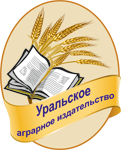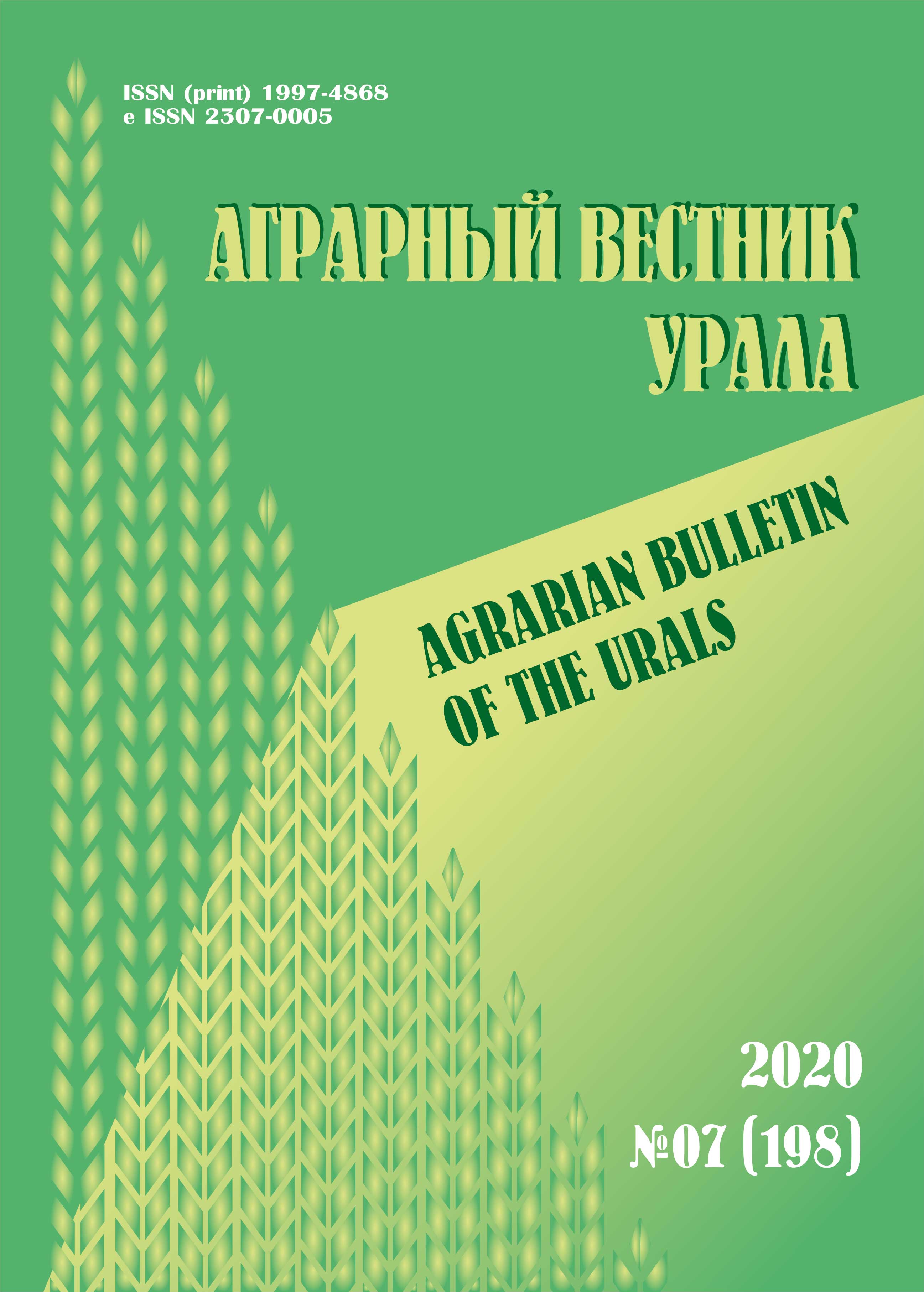Russian Federation
Abstract. In modern conditions of intensification of the agro-industrial complex of our country, the level of influence of stress factors on the indicators of dairy productivity of cattle is an urgent topic for research. According to scientists, the stress resistance of the animal body is characterized by a number of hormones, such as prolactin, adrenocorticotropic hormone and cortisol. The scientific novelty lies in the study of the level of stress resistance of cattle with the use of intensive technologies. The purpose of our research work was to analyze the indicators of stress resistance and dairy productivity of cattle in the Urals, depending on the milking technology. Research methods. Scientific work was carried out in breeding herds of black-and-white cattle in the period 2016–2019 on the basis of agricultural enterprises of the Tyumen and Sverdlovsk regions. Distributing the evaluated heifers by types of stress resistance, the level of hormones in their blood was determined during the first lactation in the laboratory using STEROIDIF tests. Results. As a result of the analysis, it was found that in the groups where milking was used in the milk pipeline, animals with a high type of stress resistance had 22.6 % more heads compared to the groups of robotic milking. At the same time, it was noted that the first heifers with an average type of stress resistance during milking by a robot milker are a quarter more than in groups of cows when milking in a milk pipeline. Consequently, the first heifers adapt better to robotic milking. Milk yield is higher for first-time heifers milked with the help of a robot milker compared to linear milking. The difference in this case was more than 700.0 kg (17.3 %) in the studied herds. We recommend that when selecting first-calf cows for intensive milking in breeding herds of the Urals, along with generally accepted assessment indicators, the level of stress resistance of animals should be evaluated.
milk productivity of cows, stress resistance of cows, hormones, cortisol, adrenocorticotropic hormone, prolactin
1. Kurdeko A. P., Bogomol'ceva M. V., Bogomol'cev A. V. Stress: diagnostika, lechenie, profilaktika: ucheb.-metod. posobie dlya studentov fakul'teta veterinarnoy mediciny po special'nosti 1-74 03 02 «Veterinarnaya medicina» i slushateley FPK i PK. Vitebsk: VGAVM, 2017. 24 s. EDN: https://elibrary.ru/ZRLQQD
2. Donnik I. M., Chechenihina O. S., Loretc O. G. Molochnaya produktivnost' i stressoustoychivost' cherno-pestryh korov raznogo genotipa // Vestnik Kurganskoy GSHA. 2021. № 4 (40). S. 35-40. DOI:https://doi.org/10.52463/22274227_2021_40_35. EDN: https://elibrary.ru/OERVOL
3. Mironova I. V., Nigmatyanov A. A., Khabibullin R. M., Galieva Z. A., Gazeev I. R., Latypova G. F. Reference intervals of essential element concentrations in milk of black-and-white cows reared in Bashkortostan Republic of Russia [e-resource] // Trace Elements and Electrolytes. 2021. Vol. 38. No. 3. P. 148. URL: https://www.dustri.com/nc/journals-in-english/mag/trace-elements-and-electrolytes.html (date of reference: 10.04.2022). EDN: https://elibrary.ru/ECPDWH
4. Romanova N. V., Kamoshenkov A. R., Ivanova E. V. Stress i produktivnost' sel'skohozyaystvennyh zhivotnyh: uchebnoe posobie dlya vuzov. Sankt-Peterburg: Lan', 2021. 100 s.
5. Zemlyanuhina T. N. Molochnaya produktivnost' i vosproizvoditel'nye kachestva korov v zavisimosti ot ih stressoustoychivosti // Vestnik Altayskogo gosudarstvennogo agrarnogo universiteta. 2021. № 5 (199). S. 62-66. EDN: https://elibrary.ru/KLSHSO
6. Dutka V. V. Vliyanie stress-faktorov na organizm zhivotnyh // Perspektivnye etapy razvitiya nauchnyh issledovaniy: teoriya i praktika: sbornik materialov Mezhdunarodnoy nauchno-prakticheskoy konferencii. Kemerovo, 2018. S. 74-75. EDN: https://elibrary.ru/VTWIGM
7. Donnik I. M., Bykova O., Krivonogova A. S., Isaeva A. G., Loretts O. G., Baranova A., Musikhina N., Romanova A.Biological safety of cows' milk under the conditions of technogenic agricultural ecosphere when using biologically active substances // International Transaction Journal of Engineering, Management and Applied Sciences and Technologies. 2019. Vol. 10. No. 2. Pp. 203-209. DOI:https://doi.org/10.14456/ITJEMAST.2019.20. EDN: https://elibrary.ru/YZXVTV
8. Donnik I. M., Shkuratova I. A. Molecular-genetic and immunobiochemical markers in assessing the health of agricultural animals // Herald of the Russian Academy of Sciences. 2017. Vol. 87. No. 2. Pp. 139-142. DOI:https://doi.org/10.1134/S1019331617020095. EDN: https://elibrary.ru/UXKTIZ
9. Lamonov S. A., Zagorodnev Yu. P. Osobennosti adaptivnoy selekcii krupnogo rogatogo skota na stressoustoychivost'. Michurinsk: BIS, 2019. 86 s. EDN: https://elibrary.ru/UVHMQJ
10. Skorkina I. A., Lamonov S. A., Tret'yakova E. N. Znachenie tipov stressoustoychivosti korov v adaptivnoy selekcii // Vestnik Michurinskogo gosudarstvennogo agrarnogo universiteta. 2019. № 3 (58). S. 92-95. EDN: https://elibrary.ru/KICNTI
11. Lamonov S. A, Skorkina I. A. Molochnaya produktivnost' i tehnologicheskie kachestva moloka korov raznyh tipov stressoustoychivosti // Vestnik Michurinskogo gosudarstvennogo agrarnogo universiteta. 2022. № 1 (68). S. 87-94. EDN: https://elibrary.ru/THLUAU
12. Gubaidullin N., Tagirov Kh., Mironova I., Lysov Y., Gafarov F., Zubairova L., Iskhakov R., Nigmatyanov A., Bagautdinov A., Pozdnyakova E. The efficiency of haylage use conserved by the pure culture of propionibacteria in black-and-white cattle feeding // Bulgarian Journal of Agricultural Science. 2019. Vol. 25. No. S2. Pp. 74-79. EDN: https://elibrary.ru/WXSUCG
13. Chechenihina O. S., Stepanova Yu. A. Stressoustoychivost' i pokazateli produktivnogo dolgoletiya korov raznyh porod // Molochnohozyaystvennyy vestnik. 2019. № 4 (36). S. 133-140. EDN: https://elibrary.ru/ZEXUHR
14. Chernyakova V. V., Zelenskaya L. A. Vliyanie stressa na molochnuyu produktivnost' krupnogo rogatogo skota // Problemy v zhivotnovodstve: Materialy mezhdunarodnoy nauchno-prakticheskoy konferencii. Krasnodar, 2018. S. 97-102. EDN: https://elibrary.ru/XTIPSH
15. Bel'kov G. I., Panin V. A. Stressoustoychivost' kak faktor bioresursnogo potenciala simmental'skih i golshtin×simmental'skih korov // Zhivotnovodstvo i kormoproizvodstvo. 2018. T. 101. № 1. S. 75-83. EDN: https://elibrary.ru/UYFBQP
16. Bychkova T. K. Stress sel'skohozyaystvennyh zhivotnyh i ego fiziologicheskoe obosnovanie // Tendencii povysheniya konkurentosposobnosti i eksportnogo potenciala produkcii agropromyshlennogo kompleksa: sbornik materialov mezhdunarodnoy nauchnoy konferencii. Smolensk, 2021. S. 86-90. EDN: https://elibrary.ru/MWIUDM
17. Donnik I. M., Loretc O. G., Chechenihina O. S., Bykova O. A., Stepanov A. V. Ocenka tipa stressoustoychivosti korov-materey i ih potomkov // Agrarnyy vestnik Urala. 2020. № 10 (201). S. 43-49. DOI:https://doi.org/10.32417/1997-4868-2020-201-10-43-49. EDN: https://elibrary.ru/IGVETK
18. Chupsheva N. Yu., Karamaev S. V., Karamaeva A. S. Produktivnoe dolgoletie korov raznogo tipa stressoustoychivosti // Izvestiya Samarskoy gosudarstvennoy sel'skohozyaystvennoy akademii. 2020. № 3. S. 39-45. EDN: https://elibrary.ru/TZGSKS
19. Hachatryan A. A. O celostnosti ob'ekta biologicheskogo poznaniya // Uchenye zapiski Kazanskoy gosudarstvennoy akademii veterinarnoy mediciny im. N. E. Baumana. 2013. T. 216. S. 363-366. EDN: https://elibrary.ru/RGEFWF
20. Priymak A. B. Sochetannoe primenenie povedencheskih testov pri ocenke stressoustoychivosti laboratornyh zhivotnyh // Molodezh'. Nauka. Tvorchestvo: materialy XIX Vserossiyskoy nauchno-prakticheskoy konferencii. Omsk, 2021. S. 60-64. EDN: https://elibrary.ru/DANMDA
21. Chupsheva N. Yu., Karamaev S. V., Karamaeva A. S. Produktivnoe dolgoletie korov raznogo tipa stressoustoychivosti // Izvestiya Samarskoy gosudarstvennoy sel'skohozyaystvennoy akademii. 2020. № 3. S. 39-45. EDN: https://elibrary.ru/TZGSKS
22. Borshch O. A., Borshch O. V., Kosior L., Lastovska I., Pirova L., Jalil G. N. Productivity of cows of different tolerance to stress under robotized milking conditions // Animal husbandry products production and processing technology. 2018. No. 1 (141). Pp. 18-24.
23. Zagorodnev Yu. P. Robotizaciya doeniya i otbor korov [Elektronnyy resurs] // Nauka i Obrazovanie: elektronnyy nauchnyy zhurnal. URL: http://opusmgau.ru/index.php/see/article/view/2144/2143 (data obrascheniya: 15.04.2022).









